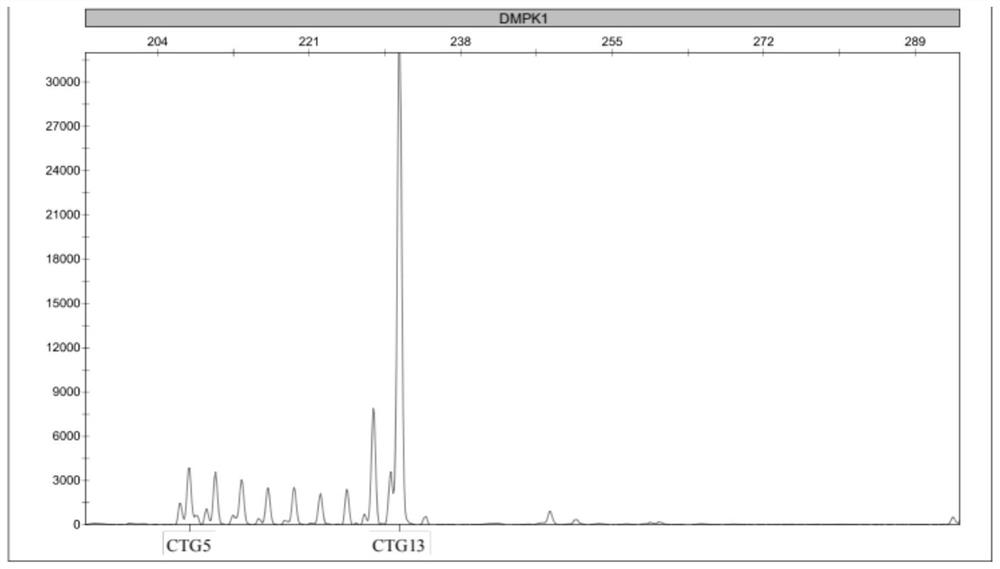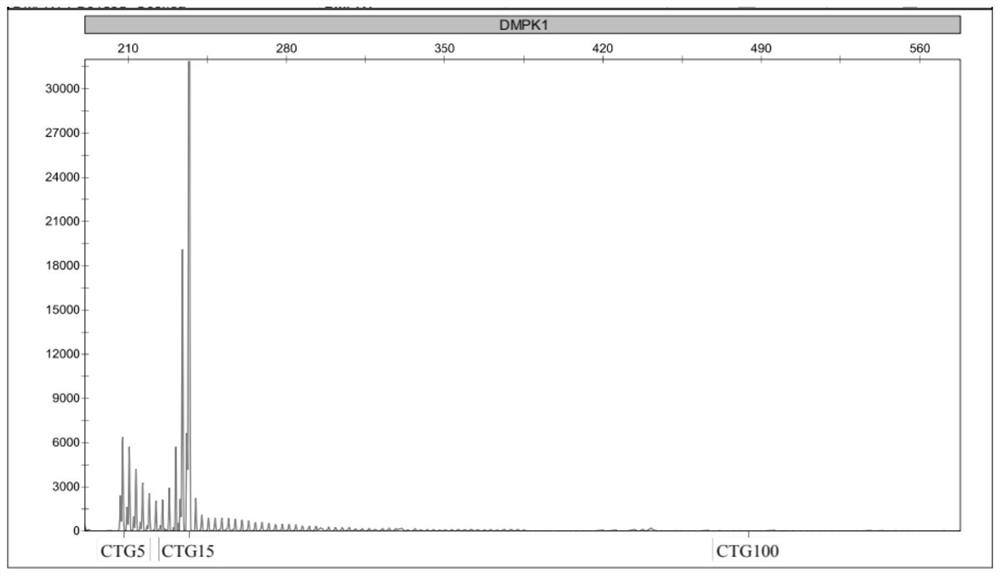PCR (polymerase chain reaction) detection kit for CTG (cytotoxic T G) region of atrophic myotonin kinase gene and application of PCR detection kit
A protein kinase gene and detection kit technology, which is applied in the field of PCR amplification, can solve the problems of inaccurately giving the number of repetitions, difficulty in detecting large fragments, and difference in results, etc., to overcome false negatives and small amplification bias , the effect of easy operation
- Summary
- Abstract
- Description
- Claims
- Application Information
AI Technical Summary
Problems solved by technology
Method used
Image
Examples
Embodiment 1
[0028] Example 1 Design of specific primer pairs and comparison of amplification efficiency
[0029] The purpose of this example is to optimize specific primer pairs for the amplification of the CTG repeat region of the 3'-UTR of the DMPK gene. For this reason, the applicant has designed two sets of specific primer pairs on both sides of the target gene according to the general primer design principle, The optimal PCR amplification reaction conditions were set. The size of the target gene fragments amplified by the two groups of reactions was different. It was found that the amplification of blood samples from a pair of suspected DM1 patients with specific primers had better results.
[0030] (1) The nucleotide sequence of the specific primer pair 1 is shown in SEQ ID NO: 1 and SEQ ID NO: 2, and the size of the target gene fragment amplified by the primer pair is about 660 bp. The reaction system and reaction conditions are shown in Table 1 and Table 2, respectively.
[0031]...
Embodiment 2
[0047] Example 2 Amplification of part of TP-PCR false negative samples and verification of amplification results by next-generation sequencing
[0048] (1) TP-PCR false negative samples for amplification
[0049] In this example, 2 samples (samples P1 / P2) of patients with DM1 clinically diagnosed as being selected, the negative samples were detected by TP-PCR method, and primer pair 1 and the reaction system in Table 1 and the amplification procedure in Table 2 were used for amplification. increased, and the CTG region of the atrophic myotonic kinase gene was detected. All samples were blood DNA samples from DM1 patients. Amplification results see Figure 2-5 .
[0050] figure 2 The results showed that one of the alleles was CTG 13 repeats, and the other allele peaked too low to be detected.
[0051] image 3 The results showed that one of the alleles was CTG 5 repeats, and the other allele peaked too low to be detected.
[0052] Figure 4 and Figure 5 The results ...
PUM
 Login to View More
Login to View More Abstract
Description
Claims
Application Information
 Login to View More
Login to View More - R&D
- Intellectual Property
- Life Sciences
- Materials
- Tech Scout
- Unparalleled Data Quality
- Higher Quality Content
- 60% Fewer Hallucinations
Browse by: Latest US Patents, China's latest patents, Technical Efficacy Thesaurus, Application Domain, Technology Topic, Popular Technical Reports.
© 2025 PatSnap. All rights reserved.Legal|Privacy policy|Modern Slavery Act Transparency Statement|Sitemap|About US| Contact US: help@patsnap.com



